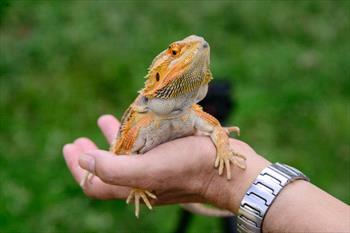Bearded dragon in persons hand

A bearded dragon. Photo courtesy of Depositphotos.
There are many different species of adenovirus that infect reptiles, and they are the most commonly identified viruses in many reptiles, particularly bearded dragons. While most adenoviruses seem to infect only one species, some can infect more than one type of reptile. Captive bearded dragons, chameleons, kingsnakes, and blue-tongued skinks are most commonly infected by adenoviruses.
The genus Atadenovirus is composed of a number of different virus species that infect specific types of reptiles:
- Agamid adenovirus 1 (bearded dragons, which is the most widespread in the U.S.)
- Chameleonid adenovirus 1 (chameleons)
- Eublepharid adenovirus 1 (leopard geckos and fat-tailed geckos)
- Gekkonid adenovirus 1 (other gecko species)
- Helodermatid adenovirus 1 and 2 (Gila monsters and beaded lizards)
- Scincid adenovirus 1 (blue-tongued skinks)
- Snake adenovirus 1 and 2 (different snake species like kingsnakes).
Another genus, Siadenovirus, infects the Sulawesi forest turtle, and there is a new genus, Testadenovirus, that infects other turtles and tortoises. Adenoviruses also infect alligators and crocodiles and seem mostly to cause liver disease in young animals, which can lead to slow growth and runting.
Most reptiles infected with an adenovirus are immune-suppressed to some degree and commonly have stomach, intestine, and liver problems; less common issues include kidney, bone marrow and brain disease. In bearded dragons, there is often a co-infection (two infections at the same time) with coccidiosis and Agamid adenovirus 1 or Mycoplasma with Helodermatid adenovirus 2.
Young, old, and stressed animals appear to be at the greatest risk of getting the disease. What is commonly seen in young animals is that they fail to thrive and grow well, don’t eat well, often lose weight, and have high death rates. Those that survive often are termed “poor doers’ for the rest of their lives. In bearded dragons infected with Agamid adenovirus 1, liver and gastrointestinal disease is commonly seen, while in older animals chronic gastrointestinal disease is seen more often. Bearded dragons infected with Helodermatid adenovirus 2 often have lung problems.
However, it is possible that an animal infected with adenovirus will not be sick but can still spread the disease. These animals are known as carriers and can be a problem for the other animals in the collection. We don’t know how common this carrier state is, so collections that regularly have lots of new animals are at greater risk of introducing the disease to the other animals.
Transmission is through the fecal-oral route, i.e., coming into contact with a reptile’s feces, which can then go in the mouth.
There is no known risk of infection to humans from reptile adenoviruses, so you don’t have to worry about people.
Affected Reptiles
It seems that almost any reptile can be infected. The adenovirus that infects bearded dragons (Agamid adenovirus 1), seems to be widespread in captive bearded dragon populations in the U.S.
Diagnosis
Reptiles with an adenovirus infection are usually just sick. They have non-specific signs, or what pet owners sometimes call “poor doers” or “ain’t doing right.” This means that your animal has signs of illness that could have many causes. Your veterinarian will start by taking a thorough medical and husbandry history and give a physical examination. Blood will be taken from your reptile for a complete blood count and plasma chemistry in addition to X-rays.
There are now a few specific tests to determine if your reptile has an adenovirus infection; all are polymerase chain reaction (PCR) tests. Regardless of the type of PCR used, the products should be sequenced to make sure which type of adenovirus is there (these tests can identify adenoviruses of prey animals). The best sample for this test is from the cloaca, and this process is often called a cloacal wash or cloacal swab. Neither a wash nor a swab requires sedation.
Treatment
Unfortunately, there is no specific treatment. Supportive treatment measures include fluids, antibiotics, and force-feeding. Feeding tubes can also help and the red-rubber catheter or metal ones of the appropriate size can be used. We don't know which reptiles might respond, and it may not help at all.
To help with recovery, reduce stress by not handling your reptile unnecessarily during treatment, and make any husbandry changes suggested by your veterinarian.
Many reptiles that survive infection with adenovirus become carriers and can still transmit the disease to others. Discuss this with your veterinarian.
One drug that can be used for treating infections with adenovirus is called cidofovir. This drug has been found to be effective in treating mammals; you may also want to discuss this with your veterinarian.
Prevention
The goal is not to allow the disease to enter your collection. Quarantine monitoring is critical: all reptiles coming into a collection should have a PCR test performed for adenoviruses before they join.
Using separate clean utensils for each cage and washing hands between cages and handling animals are essential as the main mode of transmission is transferring the feces of infected animals to uninfected animals on cleaning tools or the owner’s hands.
Providing a stress-free environment and the best husbandry practices are the most important aspects of preventing adenoviral disease.
Adenoviruses are hard to kill in the environment and so disinfection is difficult to achieve.